Raptor
Administrator


Posts : 31
Joined : 2010-01-15
Age : 36
Gender : 
Location : India
 |  Subject: B-1 Lancer Subject: B-1 Lancer  Sun Jan 24, 2010 1:47 pm Sun Jan 24, 2010 1:47 pm | |
| B-1 LANCER  ------------------------------------------------------------------------------------------------------------------------------------------------------------------- DETAILS :Role : Strategic bomber
National origin : United States
Manufacturer : North American Rockwell , Rockwell International , Boeing
First flight : 23 December 1974
Introduction : 1 October 1986
Status : In service , 66 with active duty
Primary user : United States Air Force
Number built B-1A : 4
Number built B-1B : 100
Unit cost : US$283.1 million in 1998 (B-1B)
-------------------------------------------------------------------------------------------------------------------------------------------------------------------- SPECIFICATIONS :General Characteristics : Crew : 4 (aircraft commander, copilot, offensive systems officer and defensive systems officer)
Length : 146 ft (44.5 m)
Extended Wingspan : 137 ft (41.8 m)
Swept Wingspan : 79 ft (24.1 m)
Height : 34 ft (10.4 m)
Wing area : 1,950 ft² (181.2 m²)
Airfoil : NA69-190-2
Empty weight : 192,000 lb (87,100 kg)
Loaded weight : 326,000 lb (148,000 kg)
Max takeoff weight : 477,000 lb (216,400 kg)
Powerplant : 4× General Electric F101-GE-102 augmented turbofans
Dry thrust : 14,600 lbf (64.9 kN) each
Thrust with afterburner : 30,780 lbf (136.92 kN) each
Fuel capacity, optional : 10,000 U.S. gal (38,000 L) fuel tank for 1-3 internal weapons bays eachPerformance : Maximum speed At altitude : Mach 1.25 (830 mph, 1,330 km/h)
Maximum speed at low level : Mach 0.92 (700 mph, 1,130 km/h)
Range : 6,478 nmi (7,456 mi, 11,998 km)
Combat radius : 2,993 nmi (3,445 mi, 5,543 km)
Service ceiling : 60,000 ft (18,000 m)
Wing loading : 167 lb/ft² (816 kg/m²)
Thrust/weight : 0.37
Armament : Hardpoints : Six external hardpoints for 59,000 lb (27,000 kg) of ordnance (use for weapons currently restricted by START I treaty) and 3 internal bomb bays for 75,000 lb (34,000 kg) of ordnance.
Bombs :
84× Mk-82 AIR inflatable retarder general purpose bombs
81× Mk-82 low drag general purpose bombs
84× Mk-62 Quickstrike sea mines
24× Mk-65 naval mines
30× CBU-87/89/CBU-97 Cluster Bomb Units (CBU)
30× CBU-103/104/105 Wind Corrected Munitions Dispenser
24× GBU-31 JDAM GPS guided bombs
15× GBU-38 JDAM GPS guided bombs (Mk-82 general purpose warhead)
24× Mk-84 general purpose bombs
12× AGM-154 Joint Standoff Weapon
96× or 144× GBU-39 Small Diameter Bomb GPS guided bombs (not fielded on B-1 yet)
24× AGM-158 JASSM
24× B61 thermonuclear variable-yield gravity bombs
24x B83 nuclear bomb Avionics : 1× AN/APQ-164 forward-looking offensive passive phased-array radar
1× AN/ALQ-161 radar warning and defensive jamming equipment
1× AN/ASQ-184 defensive management system
1× Lockheed Martin Sniper XR targeting pod (optional)-------------------------------------------------------------------------------------------------------------------------------------------------------------------- BACKGROUND In December 1957, U.S. Air Force selected North American Aviation's proposal to replace the B-52 Stratofortress. This would lead to the B-70 Valkyrie. The Valkyrie was a six-engine bomber that could fly very high at Mach 3 to avoid interceptor aircraft, the only effective anti-bomber weapon in the 1950s. At the time, Soviet interceptors were unable to intercept the high-flying Lockheed U-2; the Valkyrie was to fly at similar altitudes and much higher speeds. But by the late 1950s, anti-aircraft surface-to-air missiles (SAMs) could threaten high-altitude aircraft, as demonstrated by the 1960 downing of Gary Powers' U-2.
Recognizing this, the USAF Strategic Air Command had begun moving to low-level penetration before the U-2 downing. This greatly reduces radar detection distances while at that time SAMs were ineffective and interceptors less effective against low-flying aircraft. Also the flight path to a target could be routed around known anti-aircraft sites, and the landscape could be used to the bomber's advantage to stay out of the radar's line-of-sight operation. Aircraft speed became much less important. The targets themselves often had defenses located nearby to prevent this sort of approach all the way in, but stand-off weapons such as the AGM-69 SRAM provided an attack capability from outside the defensive missile's range. Low-altitude flight also made the bombers very difficult to detect from aircraft at higher altitudes, including interceptors, as radar systems of that generation could not "look down" due to the clutter that resulted from ground reflections.
Operations at low levels would limit the B-70 to subsonic speed, while dramatically decreasing its range due to much higher fuel requirements. The result would be an aircraft with similar speed but much less range than the B-52 it would have replaced. The Mach 2 B-58 was similarly limited to subsonic speeds at low altitudes. Unsuited for this new role, the viability of the B-70 as a bomber was questioned. Citing high cost, a growing ICBM force, and poor survivability against missiles, the operational bomber fleet was canceled in 1961 by President John F. Kennedy, and the program was changed to a supersonic research program with two XB-70 prototype aircraft.
Although never intended for the low-level role, the B-52's flexibility allowed it to outlast its intended successor as the nature of the air war environment changed. The B-52's large airframe and ample internal room made it relatively simple to add greatly improved electronic countermeasures suites. The "big belly" modifications increased the B-52's bomb load to 60,000 pounds (27,215 kg) during the Vietnam War. That was not to say the B-52 was a perfect aircraft. Higher speed would aid even a low-level approach in the strategic role, something the F-111 was taking advantage of. In the high-load tactical role the B-52 was limited to a small number of airfields due to its long takeoff distance. By the early 1960s the state of the art in engine and airframe design had improved considerably; an aircraft designed to match the B-52 in performance could meet both of these additional requirements as well.-------------------------------------------------------------------------------------------------------------------------------------------------------------------- DESIGN The B-1 has a blended wing body configuration, with variable-sweep wing, triangular fin control surfaces and four turbofan engines, to improve range and speed with enhanced survivability. Forward-swept wing settings are used for takeoff, landings and high-altitude maximum cruise. Aft-swept wing settings are used in high subsonic and supersonic flight. The wings of the B-1B originally were cleared for use at settings of 15, 25, 55, and 67.5 degrees. The 45-degree setting was later cleared in 1998–99 timeframe.
The length of the aircraft presented a serious flexing problem due to air turbulence at low altitude. To alleviate this, Rockwell included small canards near the nose on the B-1. An accelerometer would actuate the canards automatically to counteract turbulence and smooth out the ride.
B-1B Cockpit at night.Unlike the B-1A, the B-1B made no attempt at Mach 2+ speeds. Its maximum speed at altitude is Mach 1.25 (about 950 mph or 1,530 km/h), but its low-level speed increased to Mach 0.92 (700 mph, 1,130 km/h).[25] Technically, the current version of the aircraft can exceed its speed restriction, but not without risking potential damage to its structure and air intakes. The B-1A's engine was modified slightly to produce the F101-102, with an emphasis on durability, and increased efficiency. The core of this engine has since been re-used in several other engine designs, including the F110 which has seen use in the F-14 Tomcat, F-15K/SG variants and most recent versions of the F-16 Fighting Falcon. It is also the basis for the non-afterburning F118 used in the B-2 Spirit bomber and the U-2S. However its greatest success was forming the core of the extremely popular CFM56 civil engine, which can be found on some versions of practically every small-to-medium sized airliner. The nose gear cover door has controls for the auxiliary power units (APUs), main gear doors and nearby entry ladder. One of controls there allows for quick starts of the APUs upon order to scramble.
The B-1's offensive avionics include the Westinghouse (now Northrop Grumman) AN/APQ-164 forward-looking offensive passive electronically scanned array radar set with electronic beam steering (and a fixed antenna pointed downward for reduced radar observability), synthetic aperture radar, ground moving target indicator (MTI), and terrain-following radar modes, Doppler navigation, radar altimeter, and an inertial navigation suite. From 1995 on, the B-1B Block D upgrade added a Global Positioning System receiver.
B-1B releasing bombs and ejecting a MJU 23 decoy flare.The B-1's defensive electronics include the Eaton AN/ALQ-161 radar warning and defensive jamming equipment, linked to a total of eight AN/ALE-49 flare dispensers located on top behind the canopy, which are handled by the AN/ASQ-184 avionics management system. The AN/ALE-49 dispenser has a capacity of 12 MJU-23A/B flares each. The MJU-23A/B flare is one of the world's largest infrared countermeasure flares having a gross weight of ~1170 g. The cylindrical Magnesium/Teflon/Viton pellet has a net weight of ~1470 g. The Plans for a defensive systems upgrade program (DSUP) were canceled for budgetary reasons. The B-1 has also been equipped to carry the ALE-50 Towed Decoy System. The Lancer has an additional Doppler tail-warning radar to detect aircraft or missiles approaching from the rear.
Also aiding the B-1's survivability is its relatively low radar cross-section (RCS). Although not technically a stealth aircraft in a comprehensive sense, thanks to the aircraft's structure, serpentine intake paths and use of radar-absorbent material its RCS is about 1/50th that of the B-52 (probably about 26 ft² or 2.4 m²), although the Lancer is not substantially smaller in mass than the Stratofortress.
A B-1B at the 2006 Miramar Airshow.The B-1 has been upgraded since production through the "Conventional Mission Upgrade Program". This multi-stage program added a new MIL-STD-1760 smart-weapons interface that enables the use of the Joint Direct Attack Munition and other precision-guided conventional weapons, such as the Wind Corrected Munitions Dispenser (WCMD), the AGM-154 Joint Standoff Weapon (JSOW), and the AGM-158 JASSM (Joint Air to Surface Standoff Munition). Future precision munitions include the GBU-39 Small Diameter Bomb. These and other improvements are intended to ensure that the B-1 will be viable through approximately 2020. In addition, the Air Force has recently announced a program to keep the aircraft flying until at least 2040.
-------------------------------------------------------------------------------------------------------------------------------------------------------------------- VARIANTS B-1A/B ::
The B-1A was original B-1 design with variable engine intakes and Mach 2.2 top speed. Four prototypes were built.
The B-1B is the improved B-1 design with reduced radar signature and a top speed of Mach 1.25. A total of 100 B-1Bs were produced.
B-1R ::
The B-1R is a proposed replacement for the B-1B fleet. Boeing's director of global strike integration, Rich Parke, was first quoted about the "B-1R" bomber in Air Force Magazine.[43] Parke said the B-1R (R stands for "regional") would be a Lancer with advanced radars, air-to-air missiles, and Pratt & Whitney F119 engines (originally developed for the F-22 Raptor). Its new top speed of Mach 2.2 would be purchased at the price of a 20% reduction of the B-1B's combat range. This proposal would involve modifying existing aircraft. The FB-22 and YF-23-based design are alternative proposals.
Boeing's proposal appears to modify the B-1B into a design able to serve these two purposes. For the bomb-truck role Boeing proposes the modification of existing external hardpoints to allow them to carry multiple conventional warheads, dramatically improving overall warload. For the air-to-air role, both defensive and offensive, they propose to add active electronically-scanned array radar and allow some of the hardpoints to carry air-to-air missiles. Even with its somewhat reduced range as compared to the original B-1B, its fuel capacity remains quite large. This would allow it to escape from unfavorable air-to-air encounters by simply running away; there are few enough aircraft capable of Mach 2+ performance in general, and those that are deployed can maintain these speeds for only very short periods of time.
In general terms the B-1R most closely resembles the original F-111 concept, as opposed to a pure bomber role. However, it would be able to carry out these missions at ranges even greater than the F-111.-------------------------------------------------------------------------------------------------------------------------------------------------------------------- UPGRADES The Conventional Mission Upgrade Program (CMUP) will enhance the airplane's effectiveness as a conventional weapons carrier. Capability will be delivered in blocks attained by hardware modifications and software updates.
Block A ::
Standard design of the B-1B with the capability to deliver non-precision Mk-82 500 lb gravity bombs. Before CMUP all B-1Bs were designated as "Block A" models.
Block B ::
Improved Synthetic Aperture Radar, as well as some upgrades to the Defensive Countermeasures System. This upgrade reached the field in 1995.
Block C ::
"Enhanced Capability" provided for delivery of up to 30 Cluster Bomb Units (CBUs) per sortie. The upgrade consists of modification for B-1B bomb module from the original configuration of 28 x 500 lb bombs per unit to 10 x 1,000 lb cluster bombs per bomb rack. The modifications were made to 50 bomb racks. This capability was completed in August 1997.
Block D ::
"Near Precision Capability" gives B-1 aircrews increased abilities to accurately put bombs on target with improved weapons and targeting systems, as well as giving them advanced secure communications capabilities. The first part of the electronic countermeasures upgrade, addition of Joint Direct Attack Munitions (JDAM), ALE-50 Towed Decoy System, and anti-jam radios are also included.
Block E ::
This upgrade covers improvements to the avionics computers. This package also incorporates the Wind-Corrected Munitions Dispenser (WCMD), the Joint Standoff Weapon (JSOW) and the Joint Air-to-Surface Standoff Missile (JASSM), substantially improving the bomber's capability. Upgrades were completed in September 2006.
Block F ::
The Defensive Systems Upgrade Program (DSUP) improves the aircraft's electronic countermeasures and jamming capabilities. This includes the Towed Decoy System (TDS). Upgrades were canceled in December 2002 due to cost overruns and schedule slips.
After the CMUP program, upgrades will provide for better network centric capability. A program was begun in 2005 to provide integrated data linking and upgraded crew station displays.[48] Integration of the Sniper targeting pod is underway. The pod is mounted on an external hardpoint at the aircraft's chin near the forward bomb bay. Due to accelerated testing the Sniper pod was fielded in summer 2008.-------------------------------------------------------------------------------------------------------------------------------------------------------------------- IMAGE GALLERY 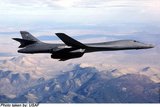 . 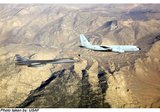 . 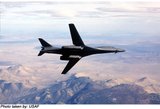 . 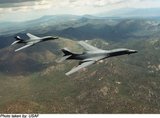  .  .  .  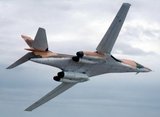 .  . 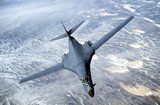 .   .  | |
|
Grievous
Posts : 4
Joined : 2010-02-07
 |  Subject: Re: B-1 Lancer Subject: Re: B-1 Lancer  Sun Feb 07, 2010 3:03 pm Sun Feb 07, 2010 3:03 pm | |
| I really like this bomber. Looks like a mix of a jet and planet. It packs the firepower needed. | |
|
